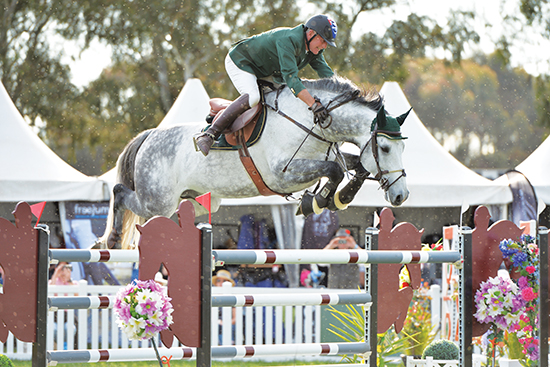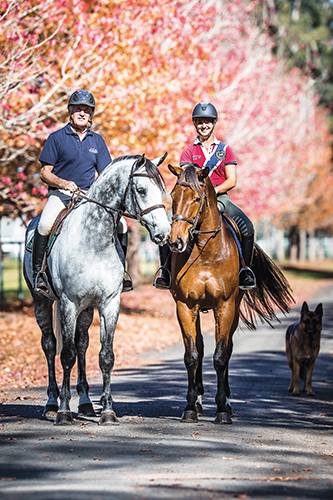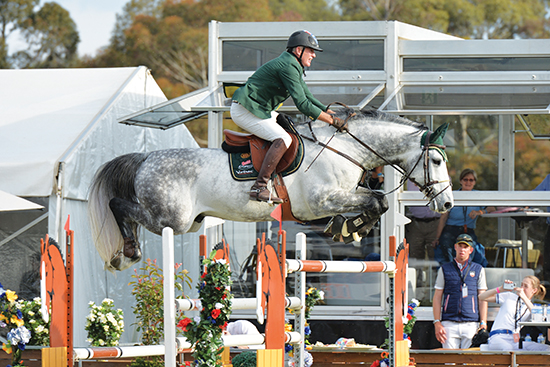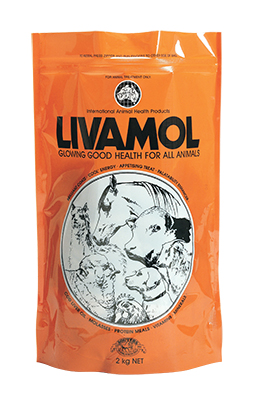 Our December International Animal Health rider of the month is Chris Chugg who has been dominating the Australian World Cup Showjumping circuit with three wins so far. It is quite a feat since Chris first represented Australia at a World Cup final back in 1986 on the stallion, Skyhigh. Since then Chris has ridden in three World Cup finals, and is aiming to get to his fourth next year…
Our December International Animal Health rider of the month is Chris Chugg who has been dominating the Australian World Cup Showjumping circuit with three wins so far. It is quite a feat since Chris first represented Australia at a World Cup final back in 1986 on the stallion, Skyhigh. Since then Chris has ridden in three World Cup finals, and is aiming to get to his fourth next year…
Lot’s of riders flash onto the scene with one or two horses, but then they disappear, but you seem to have the ability to find one horses after another, year after year… what is the secret?
“I’m hungry (he’s laughing) I sell them, and when there is a space in the stable, you have to replace them. I’m always looking for the quality horse that will suit what I need to do for the following four years, quality horses with a project in mind, and a sale in mind. If you don’t go looking, you don’t find them. We look all over the world, but lucky enough we found two here, there’s Cassiago and also Cera Carlina (Clearway / Capone / Falkland), she is a lovely mare as well and came from Kerri Parker, like Cassiago.”
“I just keep adding to the team. Eight year olds can go to the Olympics by the time they are nine, then you need seven year olds for the next world championships. I’m very lucky I’ve got a lovely five year old, Dito (Diarado / Canturo) who won the six year old class at the Winning’s show, I bought him at the Holstein Auction. Then I have Chantilly (Chacco Blue / Baloubet du Rouet / Cento) who I recently bought. She couldn’t come in because of the Glanders scare. She was competed over there by a friend, first and a second in 1.30m, she’s come back home now, and joined the team.”
“It looks like I am going to have to take the same horses back to Europe in January / February, I am probably going to have to take four horses back with me.”
But you have changed where you are looking, you are not at the Scone Sales looking for another Mr Currency…
“Unfortunately the golden egg is not to be found in those places any more. I’m sixty in five years, so I need horses that will fit my age group. I need horses that can come together over the next ten or fifteen years, and unfortunately you do have to go overseas and spend a little more, but when you sell the horses, it pays well, and you move on to the next horse. It is a sport that is growing in all the EU countries as well as Saudi Arabia and everywhere else, so the market is enormous at the moment, if you don’t act, you’ll miss out.”
Chris and his partner, fellow Showjumper, Gabi Kuna
With such a range of horses do you have to have a very flexible training policy or do you basically have a program that they have to fit into?
“I buy horse that has natural instincts. When they’ve got a natural instinct to jump, it is very easy, you only have to allow the horse to follow its natural course. I try not to buy horses that are projects, horses that are damaged goods, or horses that are dealing horses that need to be bought and sold in the first year. I look for horses with five-star quality. I’ve just been looking at another mare, from Holland, who looks like she’ll join the team. She’s a lovely five-year-old mare. It’s funny, I rang up about a young rider horse, and the guy said, sure I’ve got young rider horses, but are you looking for anything special? I said, I always look for special four and five year olds. He said, can it be green? I said, it can be just sat on, just broken in, but it must show the quality of a horse that is six or seven years old when it jumps. He sent me the video, and it looks fantastic. It certainly looks good enough for me to get on a plane and go and have a look. If she is as good as the video we will probably buy her…”
Is your program mainly flatwork?
“A little bit of jumping, a little bit of flatwork. These horses can all canter, they have natural canters so you don’t have to train them. You don’t have to train the half halt to improve the canter. I look for horses like that – then you are just treading water with them as you take them up the grades. They are not the sort of horses that need a dressage rider for six months, these horses are naturally broken in, with a good canter and the trot is not important to our sport. I look for horses that can canter or trot to a fence and feel like they are ready to go to a show, even though they are only four years old. Then I give them time, I wait till they are five.”
“It’s an interesting program, there is no great format. The work for every horse is individually tailored, but I do look for a very similar style of horse. If I get a big horse like Cassiago that wants to be a bit of a diesel, I teach him to be more of a forward thinker, and create a lot more blood out of him. That’s why I have had success with him, but it was always sitting there, he was just ridden a little different from the way I ride. I look at horses and ask myself, if they are diesels, can I wake them up, are they going to show me a bit of blood, can I get them fitter than most people, and make them enjoy their job a bit more.”
“I don’t look for a lot of roundness in the flatwork, or when I am jumping, the horse is going in his natural frame, and that normally means that the fence makes the shape of the horse. It is hard to explain, but I let the horses have a natural head carriage, I’m not someone who disciplines the horses with their necks down in running reins every day, lots of two-track and shoulder-in work – I just want horses that go straight, slow down and go forward, and when they get to a jump they know how to use their wither and neck, and from then on it is just happy times. Every day you ride them, you put them away in the stable and say to yourself, I’m really happy I bought this horse.”
Chris and Cassiago at the Australian Showjumping Championships
It was interesting what you said about fitness, I came from the Euro Champs to the Oz Champs, and a lot of the Australian horses looked fat…
“A big horse has to land on his front legs, and I am very aware of the body weight of the horses and the athleticism of the horses. I interval train, I swim them, I canter a lot. I watch their diet because the horses live in paddocks and this time of the year, we’ve got the beautiful spring grass. I buy oaten hay, I don’t feed a lot of lucerne hay. My Prydes EasiResult and EasiResponse are perfectly formulated for working horses so you don’t need a lot of additives. Of course we use electrolytes, Virbac’s Humidimix electrolytes and white E plus selenium to support muscle recovery and Rose-Hip Vital to keep their joints in top shape year after year. ”
“It is very important for a horse to be fit enough to do three days…”
Does that mean a lot of miles?
“It does, but I don’t do a lot of miles on their legs. I basically work my horses more on straight lines than most people. I only work horses on an arena that is very large, I don’t work horses on small arenas because I don’t want them turning all the time on their front legs. A big horse like Cassiago, his routine is swim twice a week, and be cantered in straight lines a couple of times a week. Maybe not even jump before a big show, but I use the first day of the show as the first jump of the week, where most people are jumping Wednesday and Thursday to go to a show on Friday, I used Friday’s class as a warm up and that is why I might not win a lot of Fridays, but by Sunday my horse is going well.”
Has poor Gabi got the ride back on her mare Cristalline yet, or is her hand still injured?
“I haven’t given her back yet. Gabi’s fingers are out of plaster, stitches out and she is having physio, so it looks like I might keep the ride out through to the showjumping at Adelaide four-star, and then I would say, we’ll go to Europe, with Cassiago, Cristalline, Chantilly and Dito. We’ll spend six months there, and probably come back just before the Winnings Show, if we are lucky enough to get to Rio. The World Cup final is going to be a great class, it opens doors to go to other shows. Hopefully I’ll be able to get into some indoor shows prior to the World Cup final, and then it will snowball on to springtime, and hopefully a good lead up to the Rio trials. I think the stallion is ready for it, he is on the improve, he doesn’t really care if he jumps a 1.60 track or a 1.50 track. It will be great preparation being there for four months beforehand on the outdoor circuit.”
Each Rider of the Month receives a prize supplied by IAHP.
This month, the Rider of the Month receives a 2kg bag of Livamol valued at $19.80.
A palatable blend of proteins, energy and polyunsaturated oil formulated to improve coat condition and general appearance of all stock, including stud and show animals. LIVAMOL is especially appropriate for young, aged and convalescing animals recovering from disease or injury.

